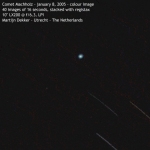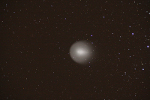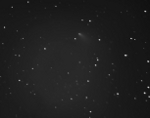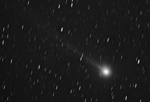 | Comet Machholz.
date: january 8, 2005
equipment: LX200@f/6.3, LPI. |
 | Comet 17P/Holmes. This comet was moving away from the sun, so was dimming. Until suddenly it exploded and brighted significantly and was visible with the naked eye and became bigger than the full moon! This was taken with the Z80 and 350D. 11-nov-2007.
|
 | Comet Hartley 103P. 9 October 2010. This comet was quite bright, but with a very low surface brightness, making it difficult to see. It was also moving very fast, as you can see from the long star trails. Equipment: 10" LX200 @ f/6.3, ATIK 16HRC, 15x90seconds. Unguided, frames with guide errors deleted, which explains the holes in the startrails.
|
 | Comet 168P/Hergenrother. 27 October 2012. Early October 2012, this comet brightened suddenly from mag 15 to mag 11, and it split in several pieces end of October, a very dynamic object. Equipment: 8" RC @ f6, ATIK 383L, 5x180seconds, guided.
|
 | Comet Pannstars L4.
date: March 26, 2013
equipment: Canon 550D, 200mm telelens on a tripod. |
 | Comet Loveyjoy.
date: Jan 24, 2015
equipment: RC 8"/f6 Atik 383L+. |

